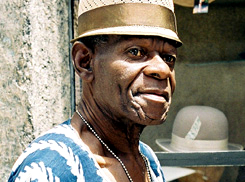Mestre Suassuna
Founder of the Group Cordão de Ouro, Reinaldo Ramos Suassuna better known as Mestre Suassuna was born in Brazil in 1938 in Ilhéus and he grew up in Itabuna. Due to a physical leg handicap that he suffered during his childhood, his doctor recommended that he pursue a regular physical activity other than football. Thanks to his two friends, he discovered Capoeira in the beginning of the 50s and began training with Mestre Sururú, Arame and then Tonho Rale. He drew inspiration from the most well-known Mestres such as Mestre Pastinha, Waldemar, but particularly from Mestre Canjiquinha and Mestre Bimba. In 1965, he moved to São Paulo after being called upon to present Capoeira in the city. In September 1967, he would create the group Cordão de Ouro along with Mestre Brasilia. The group Cordão de Ouro is presently one of the oldest groups of Capoeira, as well as one of the biggest and most influential too. Mestre Suassuna is known for his talent as a Capoeirista and for his music skills, but mainly for having created the Miudinho game which is a more dynamic version of the Capoeira Angola game 'Jogo de Dentro'....
Read MoreMestre Moraes
Mestre Moraes was born as Pedro Martinez Trindade in Ilha de Maré on the 9th of February, 1950. His father, who is nowadays blind, was a Capoeirista himself and did introduce him to Capoeira at the age of 7. He started to learn Capoeira Angola in Mestre Pastinha’s academy, but back then Mestre Pastinha was already getting blind and his students, Mestre Joao Grande and Mestre Joao Pequeno, were running the school. In 1970 he joined the marines and was sent to Rio de Janeiro. There he started training some students which are nowadays known as masters, like Mestre Braga and Mestre Cobra Mansa. In 1980 he founded the Grupo de Capoeira Angola Pelourinho, one of today’s most known Capoeira Angola groups. When he came back to Salvador in 1982, he did notice that Capoeira Angola was almost extinct, the old mestres losing ground against the new elite of modern Capoeiristas. So he started organising rodas and trainings and did fight for the recognition of Capoeira Angola as the traditional art form underlying Capoeira. In the mid-80’s he and his Contra-Mestre Cobra Mansa were able to convice Mestre Joao Grande to get back to Capoeira Angola, with which they managed to...
Read MoreMestre Cobra Mansa
Mestre Cobra Mansa (born Cinézio Feliciano Peçanha, 1960 in Duque de Caxias, Brazil) commonly known as Cobrinha, Cobrinha Mansa, is a mestre or master of Capoeira Angola. He is one of the founders and the guiding light of an organization known either as FICA (in Brazil, an acronym for Fundaçao Internacional de Capoeira de Angola) or ICAF (in English, this stands for the International Capoeira Angola Foundation, which is the literal translation of the words which make up the acronym FICA). FICA/ICAF is the largest Capoeira Angola organization in the world, consisting of many local affiliates, chapters, and training centers incorporated as not-for-profits in the United States. Mestre Cobra Mansa is well known in the world of Capoeira. He started Capoeira in 1973 with Mestre Josias da Silva and Raimundo in the Rio neighborhood of Duque de Caxias. He played Capoeira in the Duque Caxias street rodas and was one of the founders of the Caxias Street Roda with Mestre Rogerio Russo and Peixinho de Caxias. In 1974 Cobra Mansa became a student of Mestre Moraes after he saw Mestre Moraes play in the Roda of Central Brazil. Prior to his dedicating his life to Capoeira Angola, he worked in photography and...
Read MoreMestre Leopoldina
Mestre Leopoldina (born in 1933) was one of the most famous Mestres from the “a velha guarda” when most of them had already passed away. He is remembered by Angoleiros as well as Regionalistas as a person with a great sense of humour, representing the old Capoeira Carioca, malicia and the traditional maladragem of Capoeira. He died in 2007....
Read MoreMestre Peixinho
Marcelo Azevedo Guimarães, known as Mestre Peixinho, was born in 1947 in Vitória, Espírito Santo. He came to Rio de Janeiro where started practicing Capoeira in 1964 with Cláudio Danadinho. In 1965, he began training with brothers Paulo and Rafael Flores in the which will become Senzala. Mestre Peixinho is one of the founders of the group Senzala and a reference for all capoeiristas in the world. He is also the mestre of capoeira and has done the most significant work within the group Senzala. He graduated in Physical Education, Federal University of Rio de Janeiro in the late 70s and went to college Administration before joining the UFRJ. He is one of those responsible for the professionalization of capoeira. He taught and lived capoeira since 1974 when he opened the famous academy in Copacabana Travessa Angrense. Mestre Peixinho was also one of the directors of the First European Meeting that took place in 1987, being one of those responsible for the spread of capoeira abroad and work done on four continents. Regardless of all that the world turns and turns that the world gives, he managed over time to remain faithful to his feelings, passing it to his students and the students of his...
Read MoreMestre Bimba
Mestre Bimba (Manoel dos Reis Machado) was born in Salvador in the year 1899 but was not officially registered until 1900, resulting in some confusion surrounding his date of birth. The son of Luiz Cândido Machado and Maria Martinha do Bonfim, Manoel was born at the Bairro do Engenho Velho, Salvador. The nickname "Bimba" came up due to a bet between his mother and the midwife during his birth; his mother bet that he was going to be a girl and the midwife bet he would be a boy. After he was delivered, the midwife said...
Read More








